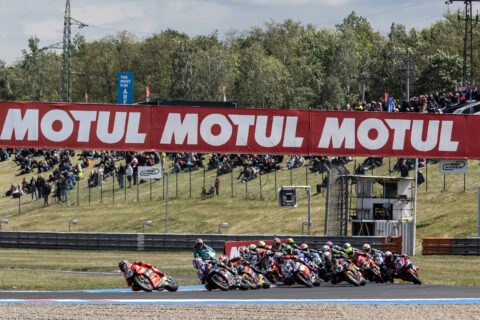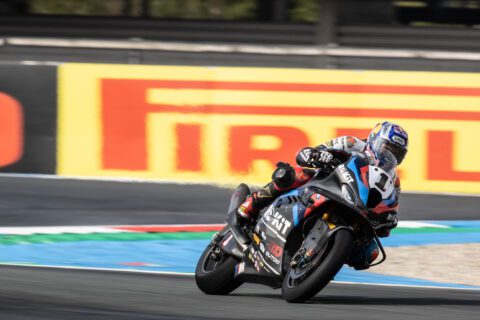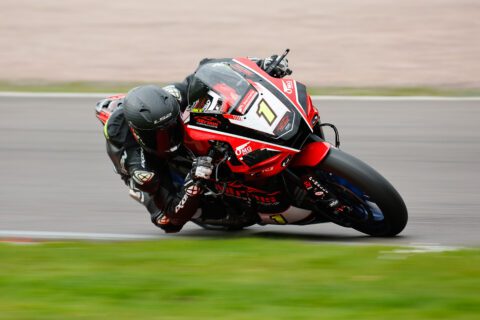Each time the exhaust valves on your bike open, a deafening belch of gas - hot enough to melt aluminium - erupts from the combustion chamber and begins its journey to the outside world. The shock waves created by just one of these events is pretty awesome but even at cruising revs on a single cylinder bike they’re
happening every 15 thousandths of a second.
It’s the exhaust’s job to quiet and direct this cacophony. That sounds pretty simple to begin with, even if the conditions are harsh. But then you get into the specifics and realise it isn’t just about moving hot gases from one place to another. A well-designed exhaust can complement an engine’s tune, smoothing some of the dips in the power delivery and enhancing the overall figures at some point in the rev range.
A bad design on the other hand, or rather the wrong design for that tune of engine, has the opposite effect. If the exhaust and engine don’t suit each other then dips in the power curve get bigger and the peak power and torque may actually drop too. In the case of standard production engines this isn’t something you need to worry about, because manufacturers across the globe can make sure their system works well and compliments that particular state of engine tune.
To understand how an exhaust system improves the performance of your engine, think about what happens with no exhaust at all. Ask anyone who’s ever run their bike without an exhaust how it was (assuming they can hear you over their tinnitus) and they’ll tell you “IT WAS REALLY, REALLY LOUD. IT DIDN’T RUN VERY WELL EITHER. YOU HAD TO NURSE THE REVS UP AND BE CAREFUL WITH THE THROTTLE. THERE WAS ONE POINT IN THE REVS WHEN IT SEEMED TO RUN OK, BUT TO BE HONEST I PUT THE EXHAUST BACK ON. IT WAS REALLY LOUD TOO, SO YOU’LL HAVE TO TELL ME IF I’M SHOUTING…”
The reason a bike generally runs rough without its exhaust is two-fold. First, your exhaust system plays a huge part in determining the intake efficiency of the engine - meaning it packs more air into the cylinder with an exhaust than without. This, in turn, messes up the fuelling for the engine, resulting in less than ideal mixes of air and fuel. So, the idea of a good exhaust system is to create those ‘sweet-spot’ conditions over the broadest possible rev range. And how the exhaust is dimensioned and designed controls this.
The first part of the system is called the header pipes. They are the bent bits that appear to come right out of the engine. No matter what the layout of the system is, the idea of the header pipes is to get the gas from the cylinder to the next part of the system as smoothly as possible. But there are numerous problems in this.
To allow the gas to move as smoothly as possible, we need to minimise reflections or sudden changes in volume (space, not noise). So a gentle sweeping bend as the gas leaves the exhaust port is desirable—except for the fact we have a radiator, forks and front wheel in the way. Because of that the header pipes on most sports bikes need to make a pretty sharp turn straight down. Compromise one.
Next, they may also have to flow around oil filters or heat exchangers protruding from the front of the engine, which means the path the separate pipes take will be of different lengths. This matters a bit, but not to the point where it will ruin the system. Instead it’s more important that the one header isn’t more restrictive than the others. That’s compromise two. We also need to consider the fact that temperature is important in exhaust design.
Ideally, the temperature of the exhaust system will remain the same from one end to the other and as hot as possible - as that give the highest gas velocity, but that never really happens, and even if it did, a small change in operating conditions could mean it no longer holds true. What designers can do, though, is minimise the likelihood of hotspots appearing and aim for a uniform temperature drop along the system. Typically, hotspots form where the gas speed drops, like sharp bends or where the flow is restricted. So this again is important in the header pipe design as they have to deal with the gases when they are at their hottest (somewhere between 650–900°C).
Over the years there have been lots of different methods employed to improve the performance of header pipes. Hydroforming (shaping a bit of pipe using water pressure - reducing the need for cuts and welds) is one technology, but most work has been in the overall shape, especially tapering -which increases the gas velocity and improves the exhausts ability to scavenge (empty) the cylinder as the exhaust valve opens. The importance of high velocities is one reason why you don’t see huge header pipes (and space and weight of course). It’s easy to think bigger is better when it comes to exhausts but this is rarely the case.
After the header pipes the next section is called the collector or secondary pipe. Typically this is the bit immediately below the engine, and is the part that dictates whether an exhaust is referred to as a 4-1 (say “four-into-one”), 4-2-1, or a 4-1-2. Those numbers describe how the separate header pipes merge. So if two headers merge into one pipe, and the other two merge into another, we’ll be left with exhaust gas coming out of two pipes. If those two pipes go on to merge into one, then all the exhaust gas from the bike will emerge from that one bit of pipe. And in that case we’d describe the layout of the system as a four-into-two-into-one.
The reason this layout is important is because it decides which characteristics of an engine a system will enhance. For instance, as a rule of thumb a 4-1 layout favours top-end power while a 4-2-1 favours mid-range power at the expense of the top-end. So it doesn’t make sense to fit a 4-2-1 system to a highly-tuned engine. Equally, it doesn’t make sense to fit a 4-1 system to a bike that’s designed
for commuting.
As well as varying the layout of the system, the length and diameter play a part too. If the “2” section of the collector is longer, the engine will generally make a little more power in the mid-range. Equally, a larger diameter pipe should elicit more top-end power than a smaller one (to a point). So by changing the length, diameter and configuration of the collector section, it’s possible to enhance the characteristics you want from the engine. Although working out what those dimensions and layouts should be is a long way from easy.
As it leaves the collector the gas will make its way up one or more link pipes. These are the sections that join the collector and silencer. In the past these were no more than bits of tube, but these days they’re generally tapered, and have to weave around things like rear sets and shocks to get where they’re going. As well as encouraging the gas to flow, ground clearance is a major concern when designing these parts.
The silencer is the most recognisable part—and the one that is most often changed by owners seeking more performance. Its job is to reduce the sound wave energy moving through the gas flow by crashing waves into one another and reducing their amplitude. The downside of this is that the flow rate through the silencer won’t be ideal, and the engine sees all the twists and turns within the silencer as an increase in length, neither of which encourage lots of power.
Straight through silencers solve the flow rate problem at the cost of increased noise. The perforated tube and wadding in the silencer both serve to absorb some of the sound energy as it passes through, and if that isn’t enough, you can always ram a big baffle down its throat, which is a half-way house between race can and road-legal silencer.
The final two features common to almost all motorcycle exhausts are balance pipes and exhaust valves. Balance pipes are the inter-connecting pipes you normally see on header pipes. They join two pipes together in order to make use of the pressure imbalance between them (because they fire at different times those header pipes are at a different point in their cycle), which reduces noise allowing less restrictive components to be used further downstream and sometimes helping boost power through a certain range.
Exhaust valves can also be used to significantly reduce noise through certain parts of the rev range, but also increase the back pressure too, which can be used to give an small boost in mid-range power. The overall story is your bike needs an exhaust to run properly. And the shape of the exhaust is determined by what the bike is designed to for. You can liberate power by unrestricting the exhaust – but if you change the tune of the engine significantly, you should also consider fitting an exhaust to suit that tune.


![Shane Byrne, Monstermob Ducati, 2003 WorldSBK, action [Gold & Goose]](https://bikesportnews.com/wp-content/uploads/2025/07/Shane-Byrne-Monstermob-Ducati-2003-WorldSBK-action-Gold-Goose-480x272.jpg)







